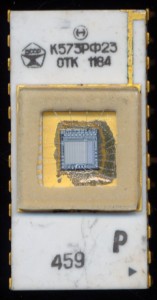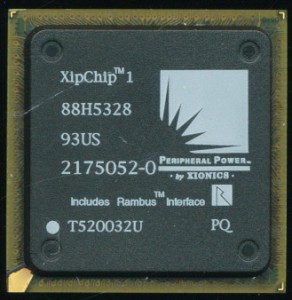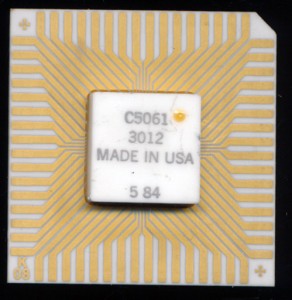
Soviet Vostok K573RF23 – 2kx4 – 1984
This EPROM, made in November of 1984 at the Soviet Vostok factory in Novosibirsk started life as a 2716 2kx8 EPROM. A Soviet 2716 would be marked as 573RF2, whereas this particular example is marked 573RF23. The die is a 2716 that was found to be defective, and thus converted to a 2kx4 EPROM, this is denoted by the adding of the 3 to the part number. This certainly was not an uncommon procedure, even Intel regularly sold 2708 EPROMs as 2704s, whether to use a die with an imperfection, or to simply meet demand.
There are two other interesting markings on this particular EPROM. First is the CCCP logo, this is the State Quality Mark of the USSR. This quality mark was used to signify that products met the following conditions:
- “meets or exceeds the quality of the best international analogs”,
- parameters of quality are stable,
- goods fully satisfy Soviet state standards,
- goods are compatible with international standards,
- production of goods is economically effective and
- they satisfy the demands of the state economy and the population.
Meeting these conditions allowed the factory to sell such devices at a 10% premium. So not only was Vostok able to pass a defective part as a quality part, they were able to do so and make a bit extra revenue. Thats something Intel would be quite envious of.
Some references show that 573RF23 as being the equivalent of a 2758 EPROM (5V 2708). This is in fact incorrect. A 2716 converted to a 2708 is done so simply by removing a single address line (going from 11 to 10) The 573RF23 retains 11 address lines, but it removes 4 data lines, thus making it 2kx4, same number of address locations, but each locations contains only 4 bits, vs 8 bits. Rewiring address lines likely did not allow for a working EPROM due to where the defect was, thus cutting the word size down. The first condition of the State Quality Mark is that said EPROM should meet or exceed the best international analog. Intel did not make a 2kx4 EPROM, the closest western analog would be the Harris/Intersil IM6657, though it was made in CMOS, vs the 573RF23s NMOS, so one could say that it was easy to beat a analog that did not exist.
The other mark on this EPROM is OTK, which literally means “Technical Control Department,” in others words this part passed the quality control dept, hopefully after it was converted to the lower capacity device, and them marked with the State Quality Mark. Perhaps it was the best NMOS 2kx4 EPROM the world was to see, certainly it came in a beautiful package.




